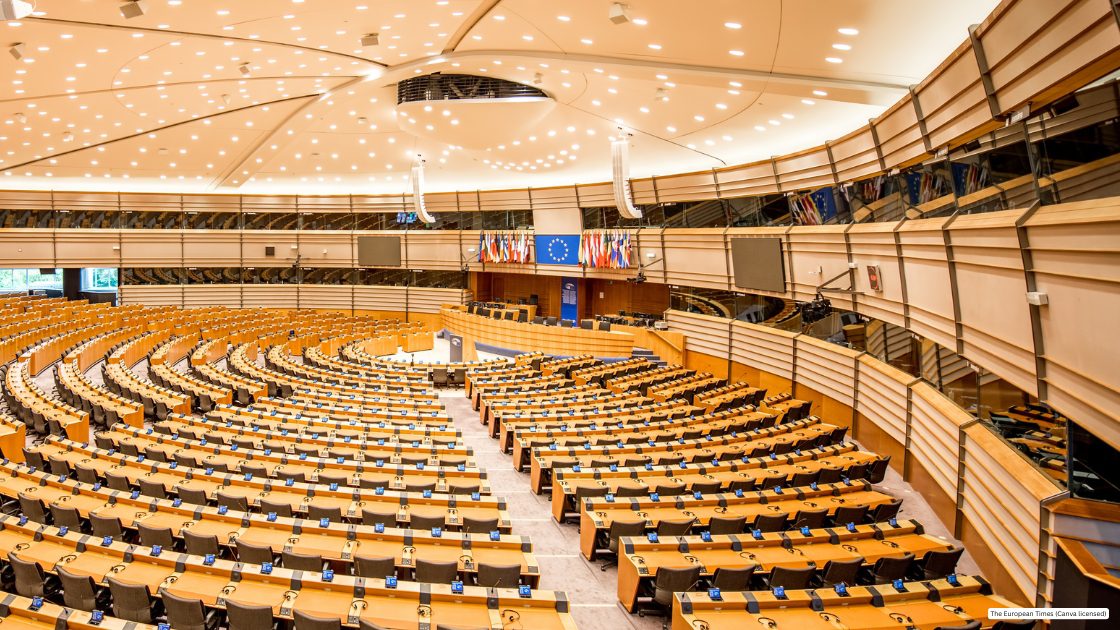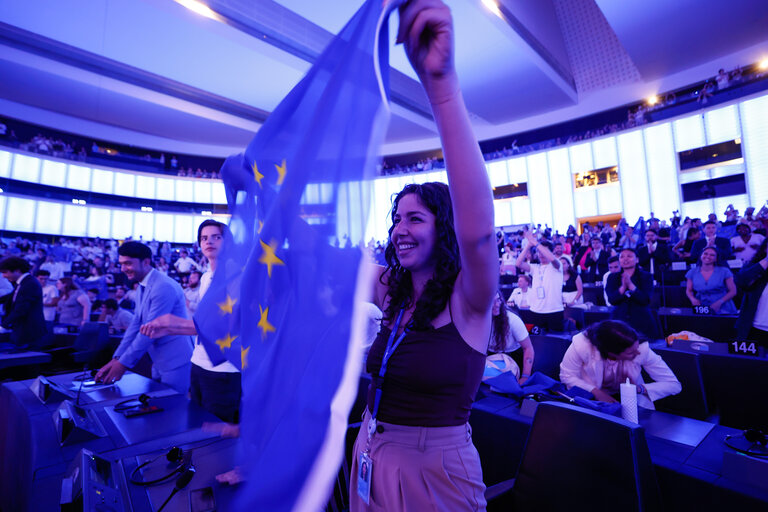Politics
An icon with an image of Stalin in the Tbilisi Cathedral was covered with paint
An icon of St. Matrona of Moscow, which also depicts Soviet commander-in-chief Joseph Stalin, was placed in Tbilisi’s Holy Trinity Cathedral. The icon was placed a few months ago, but on the eve of the Nativity of Christ in the old style, it was moved to a more central place, where it attracts the attention of visitors. Georgian historian Giorgi Kandelaki posted photos of the icon on his Facebook page with the words: “Icon of Joseph Stalin, the initiator of the destruction of Georgia’s independence, the murderer of thousands of clergy and the creator of the Soviet totalitarian system, in the Holy Trinity Cathedral.” Another success for the Russian information war machine.”
His publication found a strong public response and the patriarchate had to comment on the case. The head of the press office of the patriarchate, Fr. Andrija Jagmaidze confirmed in a conversation with the Georgian publication CNews that Stalin is indeed depicted on one of the icons in the cathedral, but reminded that the icons sometimes have images of people who insulted or persecuted the Church. He gave as an example the persecutor of Christians Diocletian, who is depicted on the icon “St. George advises Diocletian”. According to the representative of the patriarchate, it is not the icon itself that is a provocation to the feelings of the faithful, but the drawing of attention to it on the eve of the holiday.
However, his words did not convince the outraged people, who rightly note that on this icon Stalin is not represented as a torturer, as is the case with the icon of St. George, but as a meek Christian standing humbly next to a saint. She wants to legitimize the myth of Stalin’s secret Christianity, which is particularly popular among supporters of the Soviet regime.
On January 10, the icon was covered with blue paint. Civil activist Nata Peradze published footage of the painted icon. This is the reason why dozens of supporters of one of the far-right Georgian movements with a pro-Putin orientation surrounded her home and attempted to lynch her, “finishing what the state does not do.” The police did not allow suicide. As RFE/RL’s Georgian Service reported, an angry mob swarmed the house of Georgian activist Nata Peradze on January 10 after she posted a video online showing blue paint splattered on an icon of St. Matrona of Moscow in Tbilisi’s Holy Trinity Cathedral that had recently sparked controversy because it carries an image of the Soviet dictator Josef Stalin. It was initially unclear whether Peradze had defaced the icon, but as activists of the pro-Russia Alt-Info group gathered outside her home and loudly accused her of “insulting the icon,” she admitted she threw the paint.
Georgia’s Institute for the Study of the Soviet Past has called for the icon to be removed from the central Georgian temple. They remind that the icon was placed in the temple on the eve of the 103rd anniversary of the Soviet occupation of Georgia, “which began precisely on the initiative of Joseph Stalin”, and is “an insult to the memory of the victims of Soviet Russian totalitarianism”: “During Joseph Stalin’s rule in Georgia saw the execution of hundreds of clergy, most of them pastors and parishioners of the Georgian Orthodox Church, especially during the anti-Soviet uprising of 1924 and then during the Stalinist terror of 1937-1938. during Stalin’s rule, some 80,000 clergy and up to one million citizens were executed simply for their religious beliefs,” the organization said in a statement.
However, after the paint splatter incident, the icon was cleaned and placed in an even more central location in the temple, and media access to the temple was temporarily banned “without permission”.
Meanwhile, it is clear that the icon was donated to the church in Tbilisi by the leaders of the pro-Russian Alliance of Patriots party Irma Inashvili and David Tarkhan-Muravi. It aims to revive the cult of Stalin on church grounds, so that he is presented as a patron of the church and not as a persecutor. This goal is clearly recognized by the faithful who react sharply to this provocation, especially since in the recent church history of Georgia, its most popular contemporary saint Gabriel (Urgebadze) is known for his act of protest when during the Holy Week of 1965. publicly burns a portrait of Lenin with the words: “The Lord says: Do not make for yourself an idol or any image of that which is in heaven above, that is on the earth below, and that is in the water under the earth; do not bow down to them and do not serve them.’ Lenin’s portrait was carried at a demonstration on the eve of Easter, and neither the saint nor his contemporaries could have guessed that the time would come when the images of the persecutors of the Church of Christ would occupy a place of honor in the temple.
Politics
New plan will help EU countries tackle cyber-attacks better


© FRVS+MPCP 2022. The European Times® News is registered as an EU Trademark. All rights reserved. The European Times® and the logo of The European Times® are EU trademarks registered by FRVS+MPCP.
Members/Partners of

About Us
Popular Category
DISCLAIMER OPINIONS: The opinions of the authors or reproduced in the articles are the ones of those stating them and it is their own responsibility. Should you find any incorrections you can always contact the newsdesk to seek a correction or right of replay.
DISCLAIMER TRANSLATIONS: All articles in this site are published in English. The translated versions are done through an automated process known as neural translations. If in doubt, always refer to the original article. Thank you for understanding.
DISCLAIMER PHOTOS: We mostly used photos images that are readily available online, from free sources, or from the people promoting the news. If by any chance it happens that we have used one of your copyrighted photos, please do not hesitate to contact us and we will take it down without question. We do not make profits as this is a not for profit project to give voice to the voiceless while giving them a platform to be informed also of general news, and it is completely free.
Editor Picks
Politics
EYE2025 (European Youth Event): thousands to celebrate the power of democracy | News

EYE2025 (European Youth Event) will be opened by Parliament Vice-president Sabine Verheyen (EPP, DE) on Friday 13 June at 10:00 in the EYE village. Vice-president Nicolae Ştefănuță (Greens/EFA, RO) will take part in a session dedicated to the next long-term budget, on Saturday at 15:00. The closing session, with Vice-president Pina Picierno (S&D, IT), will take place on Saturday at 16:45.
Over the two days, there will be panel discussions with MEPs and other EU decision-makers, as well as with experts, activists and content creators. Debates between MEPs and the young participants will cover climate justice, skills for the future, the EU’s next long-term budget, and freedom of speech and media, among many other topics.
Commissioner for Intergenerational Fairness, Youth, Culture and Sport Glenn Micallef will lead a Youth Policy Dialogue on Friday at 11:00, and take part in a panel discussion on young people’s mental health that afternoon. Executive Vice-President of the Commission, Henna Virkkunen will join in a conversation on how technology can strengthen democracy, on Friday at 15:00.
Other guest speakers are democracy activist Daria Navalnya, the Kayapo Amazonian tribal leader Chief Tau Metuktire and the Mayor of Strasbourg Jeanne Barseghian.
The programme also includes workshops on a wide range of issues that concern young people, from disinformation to housing and migration. Quizzes, tours, artistic performances, storytelling workshops and concerts are other options among more than 450 activities organised for the sixth edition of EYE.
All sessions in the hemicycle will be streamed live on the EYE2025 Facebook page and via Parliament’s Multimedia Centre. More details about the schedule, speakers and activities are available on the European Youth Event website.
Press briefing
On Friday 13 June at 16:30, there will be a press briefing with Vice-president Verheyen on media freedom in the EU, in the Daphne Caruana Galizia press conference room. You can follow it live here.
Source link
Politics
Galician healthcare system receives nearly €510 million in EU support for its modernisation

The European Commission supports the development of the new A Coruña university hospital complex (CHUAC) in the city of A Coruña, located in the Spanish region of Galicia. The grant of nearly €60 million awarded under the Public Sector Loan Facility (PSLF), as part of the Just Transition Mechanism (JTM), complements a loan of €450 million provided by the European Investment Bank (EIB), and Xunta de Galicia’s own resources, bringing the total investment to €600 million.
This social infrastructure project of regional interest aims to expand and modernise the existing hospital complex in A Coruña. It is one of Xunta de Galicia’s major actions to strengthen its public healthcare system. The new hospital complex will include state-of-the-art infrastructure and facilities to provide comprehensive and high-quality healthcare and medical services for patients.
The resulting modern and sustainable healthcare infrastructure will improve the provision of health services and the quality of life of the citizens of Galicia, which in turn will enhance regional convergence with a significant impact on the local economy and employment.
Thanks to this project, around 564 000 people are expected to benefit from more efficient, accessible and quality health services in A Coruña and the surrounding areas. The project is also expected to create an estimated 6 140 direct and indirect jobs related to health infrastructure, representing approximately 1.3% of the employed population in A Coruña. With its energy efficiency measures, bioclimatic architecture, as well as sustainable and smart resources management, the project can substantially contribute to climate change mitigation.
This investment therefore plays a crucial role in mitigating the long-term socioeconomic consequences of the coal-fired plants closures in the region, while promoting a sustainable and an inclusive recovery for Galicia in the context of the region’s ageing demographic and green transitions.
Emma Toledano Laredo, Director at the European Commission (DG REGIO), said:
The European Commission, together with CINEA and the EIB, is very proud to bring the new A Coruña university hospital complex to life thanks to the Public Sector Loan Facility. This green, innovative and people-first project will enhance the provision of healthcare to Galicians, while bringing jobs to the region. This is yet another example of how a just and green transition can bring improvement in all sectors of a regional economy and its people.
Paloma Aba Garrote, Director of CINEA, added:
The new A Coruña university hospital complex is an excellent example of how the Public Sector Loan Facility can support European regions in their transition towards climate neutrality and improve people’s lives. Together with our partners, we are proud to invest in a sustainable and modern healthcare infrastructure, which will provide high-quality and accessible services for Galicians while fostering social cohesion, regional convergence and sustainability.
A spokesperson for the Xunta de Galicia regional government stated:
This project aiming to modernise and expand the A Coruña university hospital complex is a fundamental investment to develop the Galician healthcare infrastructure. Galicia is the first Spanish region to receive support from the Public Sector Loan Facility. Moreover, the new CHUAC project has been awarded the biggest PSLF grant so far, amounting to €59.3 million.
About PSLF
The Public Sector Loan Facility (PSLF) is the third pillar of the Just Transition Mechanism (JTM) – a key tool of the European Green Deal Investment Plan to make sure that no one and no region is left behind in the transition to a climate-neutral economy.
The PSLF combines loans from the European Investment Bank (up to around €6-8 billion) with grants from the European Commission (up to €1.3 billion). The combined support is designed to mobilise additional investments for public sector entities in the regions most affected by the green transition as identified in the Territorial Just Transition Plans, to meet their development needs as they move towards a climate-neutral economy. Each Member State creates these plans to identify the challenges faced by just transition regions, along with their development needs and targets for 2030.
The combination of the European Investment Bank loan and the EU grant will help fund projects that do not generate enough revenues to cover their costs.
PSLF is managed by DG REGIO and implemented by CINEA.
About DG REGIO
The Directorate-General for Regional and Urban Policy (DG REGIO) is the department of the European Commission responsible for EU policies on regions and cities. It develops and carries out the Commission’s policies on regional and urban policy. It assists the economic and social development of the developed and less developed regions across the European Union.
About CINEA
The European Climate, Infrastructure and Environment Executive Agency (CINEA) is an Executive Agency established by the European Commission to implement parts of EU funding programmes for transport, energy, climate action, environment and maritime fisheries and aquaculture. CINEA aims to assist its beneficiaries, establish strong partnerships, deliver high-quality programme and project management, foster effective knowledge sharing and create synergies between programmes – to support a sustainable, connected, and decarbonised Europe.
About the EIB
The European Investment Bank (EIB), whose shareholders are the 27 Member States of the European Union, is the EU’s long-term financing institution. The EIB provides loans to the public and private sectors to support high-quality investments contributing to the achievement of the EU headline targets.
Visit the PSLF webpage on CINEA website to find out more about the Facility and the projects it funds.
-
EU & the World5 days ago
Aurora Borealis Forecast: Where & When to See the Northern Lights Tonight
-

 Sports6 days ago
Sports6 days agoChampions League Final 2024-2025: PSG-Inter, official lineups
-

 EU & the World6 days ago
EU & the World6 days agoRihanna’s Parents: About Her Late Dad Ronald Fenty & Mom Monica Braithwaite
-

 Sports5 days ago
Sports5 days agoOfficial: Damien Comolli new general manager of Juventus.
-

 EU & the World6 days ago
EU & the World6 days agoLoretta Swit’s Net Worth: How Much Money the ‘M*A*S*H’ Alum Had
-

 EU & the World6 days ago
EU & the World6 days ago‘King of the Hill’ Revival: Upcoming Hulu Sitcom’s Release Date & More
-

 Sports6 days ago
Sports6 days ago“Pecco Bagnaia is a'shadow”: the'former driver celebrates Marc Marquez
-

 EU & the World6 days ago
EU & the World6 days agoTaylor Swift’s Net Worth: How Much Money She Has in 2025








